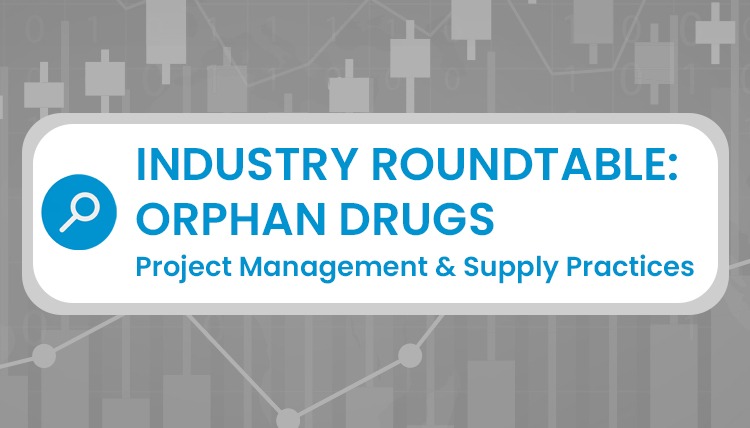CDMO Roundtable: Managing Orphan Drug Projects
Low-volume drugs, such as orphan drugs, present challenges in achieving favorable production economics and in managing the projects themselves. A roundtable of CDMOs provides perspectives on those challenges and best practices to resolve them.
CMDOs provide perspectives on projects involving low-volume drug (i.e., orphan drugs):
* Specialized considerations in supply management
* Production economics and ways to improve COGS
* Scale-up considerations
* Best practices in project management
A CDMO roundtable
To gain a perspective of the challenges in manufacturing and managing projects with low-volume drugs and the approaches taken to resolve those challenges, DCAT Value Chain Insights assembled a panel of experts from CDMOs of both drug substances and drug products to gain insights on supply planning, production economics, scale-up, and project management of low-volume drugs, such as orphan drugs.
Participating in the roundtable were: Joe Nettleton, Vice President, Strategic Initiatives, Drug Substance CDMO, and Brian Swierenga, Vice President, Operations and Site Director, High Point (North Carolina), both from Cambrex; Teresa Pallotta, Vice President, API Sales, Curia; John S. Ross, President, Metrics Contract Services and Mayne Pharma US; Paul Quigley, Principal Research Fellow, Drug Substance, and
John McDermott, Executive Drug Development Consultant, both from Quotient Sciences; and Dr. Ke Chen, Vice President and Head of API Late-Phase Process R&D, WuXi STA.
Supply management and low-volume drugs
Question: What particular challenges arise from a supply planning/management perspective when working with low-volume drugs?

Vice President, Strategic Initiatives, Drug Substance CDMO
Cambrex
Nettleton and Swierenga (Cambrex): One big challenge is diversity of sourcing. Since raw material volumes are generally low, it can be difficult to find multiple sources that are willing to share the supply chain at a low volume. This creates a risk to active pharmaceutical ingredient (API) manufacturing timelines in the event of a supply-chain interruption.
Procurement of starting materials can also become a challenge with small volumes. You need talented procurement staff who can identify companies with various technologies to make the starting material, which is typically a custom order. Experienced procurement teams, with a deep knowledge of key technology manufacturers, allow you to rapidly identify the potential suppliers. This complexity is very different compared to sourcing solvents or commodity chemicals, where price is often the deciding factor.

Vice President and Head of API Late-Phase Process R&D
WuXi STA
Chen (WuXi STA): Managing the supply chain for a low-volume drug (i.e., an orphan drug) can be challenging as the drug candidate is typically associated with accelerated CMC [chemistry, manufacturing and controls] development timeline and limited scale-up opportunity prior to commercial launch. As a result, the CMC team and the supply chain team often are ‘forced’ to make decisions with insufficient data package, trying hard to balance between timeline, process robustness, cost of goods sold (COGS) and regulatory considerations.
Furthermore, it’s becoming a common theme that a drug candidate may get launched initially for a certain disease indication with lesser patient population, and then expanded to other indications with higher volume demand. Because of the dynamic nature of clinical planning, one cannot assume that the sponsors will get the opportunity to re-develop the CMC package and supply chain prior to clinical expansion, so it’s highly advantageous to get it right the first time in terms of supply management.
Ross (Metrics Contract Services and Mayne Pharma US): It is always easier to manage a high batch count product. Think of it like getting reps at the same thing time and time again. Practice really does make perfect. That said, the contemporary needs of many drug products given rare disease pursuits or targeted therapies, require perfection on low-volume products. These types of demand profiles can surface: challenges associated with material order quantities and shelf life; operator and chemist readiness/familiarity with product-specific processes and methods; and even validations where the demand profile does not represent typical expectations for iterations of process or cleaning validation requirements. These low-volume products often forego traditional opportunities for economies of scale or even basic process improvements because the processes are infrequently touched and studied.

Principal Research Fellow, Drug Substance
Quotient Sciences
Quigley (Quotient Sciences): Most CDMOs are dependent on large-volume processes to achieve economies of scale. We take a material-sparing mindset when developing scalable manufacturing processes, which is particularly important for low-volume drugs.
Pallotta (Curia): Orphan drugs can be particularly challenging for the innovator and CDMO partner because they are producing quality medicines within tight timeframes. Core development attributes are evolving while clinical supply and trials are ongoing. At the same time, some of the challenges are not unique to low volume. Finding suppliers of raw materials and upstream intermediates is essential. At the same time, low-kilo volumes are not always compelling to a supplier, which means it can be hard to build a reliable supply chain. Experienced R&D partners are typically well equipped to manage multiple projects on a gram-to-kilo scale in parallel. We routinely operate at low volumes in multiple geographies with multiple centers as part of the development process. This expertise can be applied to low-volume drugs.
Production economics, cost of goods sold, and resolving challenges
Q: How may higher cost of goods sold (COGS) or potential diseconomies of scale be resolved when working with low-volume drugs?
Nettleton and Swierenga (Cambrex): There are specific actions that you can take to lessen the impact of the higher COGS, depending on the manufacturing process. For example, you can maximize batch volumes at the early steps of the process and hold those as intermediates. That allows you to build some economy of scale into the process. Additionally, you should look at enabling technologies that can bring down processing time and cost, e.g., continuous flow chemistry or process analytical technology.

President
Metrics Contract Services and Mayne Pharma US
Ross (Metrics Contract Services and Mayne Pharma US): In our experience, the best way to reduce some of the inherent diseconomies of scale with low-volume drugs is to standardize around routine materials and processes to the extent possible. For example, aligning non-functional excipients with those already in common and routine use enables freshly cycled material availability to a standard specification rather than bespoke, product-specific specifications which may or may not be readily available to respond to product demand. Developing a process with unit operations that are simple to execute and minimize excess extraneous portions or steps mitigates process risk in execution. Sponsors should align to the standard practices of their manufacturer to the extent possible, all with the intent to have the rarely executed product fall within frequently executed systems and processes as much as possible. This reduces risk of operator error dramatically.
Another consideration is the working capacity of the equipment. To us it makes more sense to work within optimal ranges of equipment, perhaps even at smaller batch sizes made more often, rather than at the very low end of the operating range in larger equipment. This does not necessarily have to translate into significant additional cost. Sometimes the smaller-scale equipment is easier to manage in setup and operation and working within optimal parameters improves process robustness and thus minimizes unforeseen issues that cost money to investigate and resolve and potentially delay product availability.
We also seek to maximize shelf life on low-volume products to maximize flexibility with inventory in the supply chain.
Chen (WuXi STA): Relative to other considerations (i.e., timeline, regulatory, robustness), some may consider COGS as a minor factor for low-volume drugs. Regardless, it’s beneficial for the CMC team to establish cost-effective methods to prepare drug substance and drug product during the development stage, especially considering the potential for future indications (hence higher volume demand). These efforts require both innovation and collaboration across different functional teams.
For example, an important milestone for CMC development is route selection for drug substance. Since orphan drugs tend to have an accelerated development timeline, the CMC team needs to identify and lock the synthetic route at the early stage (Phase I or even as early as the toxicology studies). Prior to the commitment, the team needs to carefully evaluate: (1) baseline cost (using the process as is); (2) areas with potential for improvement; and (3) more optimum commercial cost (assuming #2 [areas for potential improvement] gets implemented). Items #1 (baseline cost) and #3 (more optimum commercial cost) require collaboration between financial, supply chain, and external CDMO/CMO partners. Once the evaluation gets completed and selection is endorsed, the CMC team will then focus its efforts to ensure #2 (potential costs improvement) is getting explored and implemented at a suitable timing. The improvement can be achieved by many avenues. A case in point is to use high-throughput-screening to identify a supreme reagent that offers higher selectivity and yields or to develop alternative vendors to drive down the cost for certain key raw materials.

Vice President, API Sales
Curia
Pallotta (Curia): Procurement organizations have stepped into the forefront of production in recent years, enabling healthcare companies to deliver on commitments to patients. They have demonstrated extraordinary performance, resolving many apparently insurmountable supply-chain obstacles from the pandemic. Many of the approaches applied, such as establishing dual or multiple-sourcing and having a geographically diverse strategy in place for strategic supplies can address such challenges associated with low volumes. Further, clear and accurate forecasting makes a difference. If there is an accurate assessment of the annual market requirements, the manufacturing sites can plan to manufacture in multi-year campaigns to decrease production costs and maximize efficiency.
Clinical to commercial scale-up
Question: How about scale-up? Any particular challenges when scaling up from clinical to commercial scale when working with a low-volume drug? If so, how is that resolved?
Chen (WuXi STA): Scale-up the processes for a low-volume drug can be challenging as general industrial practice can lead to some blind spots for small-scale production, which in turn, lead to inconsistency in performance and even in quality.
An example is the potential contamination from general solvents such as cleaning methanol, acetone, or even water. Small amounts of residual washing solvents are unlikely to have a noticeable impact on standard pilot-scale production; however, if vigorous cleaning is not applied, this could lead to high quality impact for small-scale production.
Another challenge is to proactively gather knowledge from the scale-up experience—this is critical considering the limited production opportunity for most low-volume drugs. The CMC team is recommended to design and align the data-collection template prior to initiating production either internally or by an external CDMO/CMO. These efforts will ensure coherent data collection/verification on the often less-mature processes.
Ross (Metrics Contract Services and Mayne Pharma US): Scale-up and commercialization can be challenged by API availability (or cost) with low-volume products. This can impact the extent of process robustness work in development or sometimes impact the process validation—either insufficient material to support a full validation or a full validation represents far more supply than needed before the product reaches shelf life and becomes obsolete. One common approach we have implemented, specifically with respect to low-volume/small batch size products, is to set the registration batch size the same as the commercial batch size. In this connection, the critical process parameters can be identified, with process ranges identified, much earlier in the development cycle. Those process ranges then effectively translate into similar or identical ranges in the commercial space, provided equivalence in process equipment.

Executive Drug Development Consultant
Quotient Sciences
McDermott (Quotient Sciences): If the process of scale-up is well understood and there are appropriate processes in place to manage the scale-up from clinical to commercial scale, this shouldn’t present a technical problem as by definition low-volume drugs sit somewhere along the scale spectrum. However, low-volume drugs require expertise in controlling processes at the intended scale, sometimes with equipment that can be difficult to find in late-stage and commercial production.
Nettleton and Swierenga (Cambrex): When it comes to scale-up, there are no real unique challenges specific to low-volume drug manufacturing. Like other processes, the replication of mixing and heat transfer conditions at the varying manufacturing scales can be critical factors. Simple baffle design changes or reactor geometries may impact mixing mass transfer, which could impact impurity formation or other reaction conditions affecting yield or quality.

Vice President, Operations and Site Director, High Point (North Carolina)
Cambrex
Additionally, process validation can be more challenging at low volume because of the need to manufacture three to four batches for data generation. If you are already manufacturing at a small batch size, splitting that annual need into multiple batches can cause challenges of scale for some unit operations, e.g., filtration and drying.
Pallotta (Curia): The ability to execute seamlessly across clinical and commercial scale enables companies to avoid costly delays and advance development in parallel in different phases. Experience in reliable and predictable tech transfer is a distinct benefit to programs addressing rare disease and orphan designation. Suppliers, such as Curia, with experience in discovery through commercial scale are positioned to successfully deliver in this environment. It’s particular valuable to innovators when a single site can execute from clinical through commercial at gram scale, with scientific teams that are united by shared expertise and a collaborative process, driven by a commitment to the patients who will potentially benefit.
Project management and low-volume drugs
Question: What are some key best practices in project management when working on projects with low-volume drugs? Any specialized considerations that are taken into account compared to a traditional outsourced project? Any case studies you can offer
Chen (WuXi STA): When it comes to managing projects with low-volume drugs, one of the best practices is to make stage-appropriate decisions. One needs to identify and differentiate ‘nice-to-haves’ from ‘must-haves,’ which can be challenging when facing an insufficient data package and a dynamic timeline. Regardless, this practice is critical to ensure the program continues to hit target timelines by delivering high-quality product while maintaining a reasonable budget.
In one of our recent collaborations, we designed and executed a learn Quality-by-Design (QbD) package, followed by small-scale validation at WuXi STA’s Jinshan, China, site. These efforts enabled our client to successfully file a new drug application (NDA) in the US while delivering a reasonable amount of commercial inventory. Parallel with the NDA submission, we moved to the second stage, which involves optimization of regulatory starting material preparation (cost reduction), tightening up specifications (regulatory robustness) and three-times larger validation at WuXi STA’s Changzhou, China, site (cost reduction and supply-chain robustness). By doing so, the program is well set for global launch with enhanced robustness and lowered COGS.
Ross (Metrics Contract Services and Mayne Pharma US): The work to develop and qualify a product that will be made rarely versus a high-volume product is really the same. On low-volume programs, it is imperative to be highly considered about the studies being conducted and the data being gathered because the opportunity to augment during subsequent iterations is less available. The notion of ‘measure twice, cut once’ strongly applies with these low-volume programs.
Nettleton and Swierenga (Cambrex): The process development, analytical, and regulatory hurdles that must be overcome during drug development are largely independent of the product’s scale. Therefore, we take a similar approach to most aspects of a project when partnering with our customers on small-volume products as we would for larger volumes. That means a fully resourced project team composed of process development, analytical development, process engineering, quality control, strategic sourcing, etc. Our goal is to provide excellent service to every customer, regardless of their product’s scale. For these reasons selecting a manufacturing partner for low-volume API supply is just as important as a high-volume supply partner. The best contractors will have a proven track record in open and transparent project management, matched with strong technical expertise and modern facilities.






